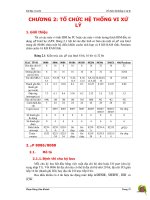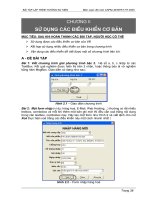Chuong 2 dns
Bạn đang xem bản rút gọn của tài liệu. Xem và tải ngay bản đầy đủ của tài liệu tại đây (781.56 KB, 49 trang )
Chapter 17
Domain Name
System: DNS
Objectives
Upon completion you will be able to:
• Understand how the DNS is organized
• Know the domains in the DNS
• Know how a name or address is resolved
• Be familiar with the query and response formats
• Understand the need for DDNS
TCP/IP Protocol Suite
1
17.1 NAME SPACE
The names assigned to machines must be unique because the addresses
are unique. A name space that maps each address to a unique name can
be organized in two ways: flat or hierarchical.
The topics discussed in this section include:
Flat Name Space
Hierarchical Name Space
TCP/IP Protocol Suite
2
17.2 DOMAIN NAME SPACE
The domain name space is hierarchical in design. The names are
defined in an inverted-tree structure with the root at the top. The tree can
have 128 levels: level 0 (root) to level 127.
The topics discussed in this section include:
Label
Domain Name
Domain
TCP/IP Protocol Suite
3
Figure 17.1
TCP/IP Protocol Suite
Domain name space
4
Figure 17.2
TCP/IP Protocol Suite
Domain names and labels
5
Figure 17.3
TCP/IP Protocol Suite
FQDN and PQDN
6
Figure 17.4
TCP/IP Protocol Suite
Domains
7
17.3 DISTRIBUTION OF
NAME SPACE
The information contained in the domain name space is distributed
among many computers called DNS servers.
The topics discussed in this section include:
Hierarchy of Name Servers
Zone
Root Server
Primary and Secondary Servers
TCP/IP Protocol Suite
8
Figure 17.5
TCP/IP Protocol Suite
Hierarchy of name servers
9
Figure 17.6
TCP/IP Protocol Suite
Zones and domains
10
Note:
A primary server loads all information
from the disk file; the secondary server
loads all information from the primary
server. When the secondary downloads
information from the primary, it is called
zone transfer.
TCP/IP Protocol Suite
11
17.4 DNS IN THE INTERNET
The domain name space (tree) is divided into three different sections:
generic domains, country domains, and the inverse domain.
The topics discussed in this section include:
Generic Domains
Country Domains
Inverse Domain
Registrar
TCP/IP Protocol Suite
12
Figure 17.7
TCP/IP Protocol Suite
DNS used in the Internet
13
Figure 17.8
TCP/IP Protocol Suite
Generic domains
14
Table 17.1 Generic domain labels
TCP/IP Protocol Suite
15
Table 17.1 Generic domain labels (Continued)
TCP/IP Protocol Suite
16
Figure 17.9
TCP/IP Protocol Suite
Country domains
17
Figure 17.10
TCP/IP Protocol Suite
Inverse domain
18
17.5 RESOLUTION
Mapping a name to an address or an address to a name is called nameaddress resolution.
The topics discussed in this section include:
Resolver
Mapping Names to Addresses
Mapping Addresses to Names
Recursive Resolution
Iterative Resolution
Caching
TCP/IP Protocol Suite
19
Figure 17.11
TCP/IP Protocol Suite
Recursive resolution
20









